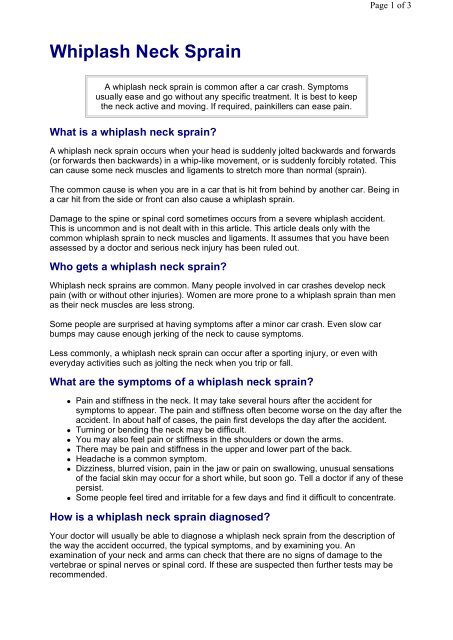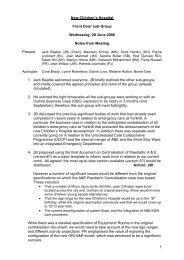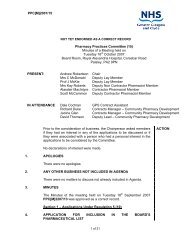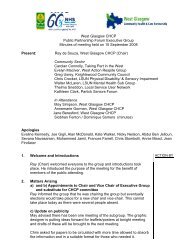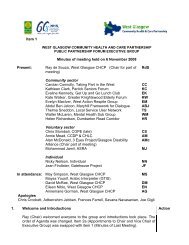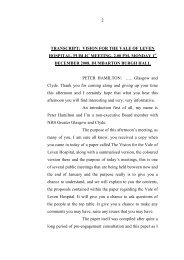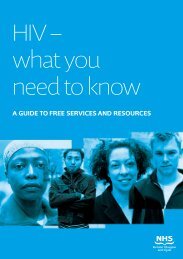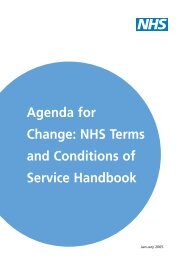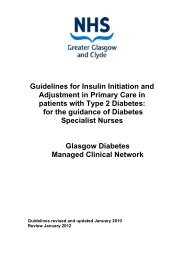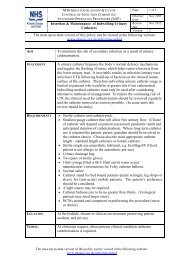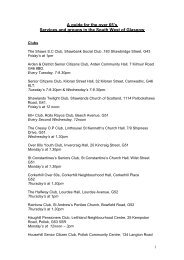Whiplash Neck Sprain
Whiplash Neck Sprain
Whiplash Neck Sprain
Create successful ePaper yourself
Turn your PDF publications into a flip-book with our unique Google optimized e-Paper software.
<strong>Whiplash</strong> <strong>Neck</strong> <strong>Sprain</strong><br />
A whiplash neck sprain is common after a car crash. Symptoms<br />
usually ease and go without any specific treatment. It is best to keep<br />
the neck active and moving. If required, painkillers can ease pain.<br />
What is a whiplash neck sprain?<br />
A whiplash neck sprain occurs when your head is suddenly jolted backwards and forwards<br />
(or forwards then backwards) in a whip-like movement, or is suddenly forcibly rotated. This<br />
can cause some neck muscles and ligaments to stretch more than normal (sprain).<br />
The common cause is when you are in a car that is hit from behind by another car. Being in<br />
a car hit from the side or front can also cause a whiplash sprain.<br />
Damage to the spine or spinal cord sometimes occurs from a severe whiplash accident.<br />
This is uncommon and is not dealt with in this article. This article deals only with the<br />
common whiplash sprain to neck muscles and ligaments. It assumes that you have been<br />
assessed by a doctor and serious neck injury has been ruled out.<br />
Who gets a whiplash neck sprain?<br />
<strong>Whiplash</strong> neck sprains are common. Many people involved in car crashes develop neck<br />
pain (with or without other injuries). Women are more prone to a whiplash sprain than men<br />
as their neck muscles are less strong.<br />
Some people are surprised at having symptoms after a minor car crash. Even slow car<br />
bumps may cause enough jerking of the neck to cause symptoms.<br />
Less commonly, a whiplash neck sprain can occur after a sporting injury, or even with<br />
everyday activities such as jolting the neck when you trip or fall.<br />
What are the symptoms of a whiplash neck sprain?<br />
Pain and stiffness in the neck. It may take several hours after the accident for<br />
symptoms to appear. The pain and stiffness often become worse on the day after the<br />
accident. In about half of cases, the pain first develops the day after the accident.<br />
Turning or bending the neck may be difficult.<br />
You may also feel pain or stiffness in the shoulders or down the arms.<br />
There may be pain and stiffness in the upper and lower part of the back.<br />
Headache is a common symptom.<br />
Dizziness, blurred vision, pain in the jaw or pain on swallowing, unusual sensations<br />
of the facial skin may occur for a short while, but soon go. Tell a doctor if any of these<br />
persist.<br />
Some people feel tired and irritable for a few days and find it difficult to concentrate.<br />
How is a whiplash neck sprain diagnosed?<br />
Page 1 of 3<br />
Your doctor will usually be able to diagnose a whiplash neck sprain from the description of<br />
the way the accident occurred, the typical symptoms, and by examining you. An<br />
examination of your neck and arms can check that there are no signs of damage to the<br />
vertebrae or spinal nerves or spinal cord. If these are suspected then further tests may be<br />
recommended.
What are the treatments for a whiplash neck sprain?<br />
Exercise your neck and keep active<br />
Aim to keep your neck moving as normally as possible. At first the pain may be bad, and<br />
you may need to rest the neck for a day or so. However, gently exercise the neck as soon<br />
as you are able. You should not let it 'stiffen up'. Gradually try to increase the range of neck<br />
movements. Every few hours gently move the neck in each direction. Do this several times<br />
a day. As far as possible, continue with normal activities. You will not cause damage to your<br />
neck by moving it.<br />
Medicines<br />
Painkillers are often helpful and may be recommended by your doctor.<br />
Paracetamol at full strength is often sufficient. For an adult this is two 500 mg<br />
tablets, four times a day.<br />
Anti-inflammatory painkillers. These may be used alone or at the same time as<br />
paracetamol. They include ibuprofen which you can buy at pharmacies or get on<br />
prescription. Other types such as diclofenac or naproxen need a prescription. Some<br />
people with stomach ulcers, asthma, high blood pressure, kidney failure, or heart<br />
failure may not be able to take anti-inflammatory painkillers.<br />
A stronger painkiller such as codeine is an option if anti-inflammatories do not suit<br />
or do not work well. Codeine is often taken in addition to paracetamol.<br />
A muscle relaxant such as diazepam is occasionally prescribed for a few days if<br />
your neck muscles become very tense and make the pain worse.<br />
Other treatments<br />
Some other treatments which may be advised include:<br />
A good posture may help. Check that your sitting position at work or at the<br />
computer is not poor. (That is, not with your head flexed forward with a stooped<br />
back.) Sit upright. Yoga, pilates, and the Alexander technique all improve neck<br />
posture, but their value in treating neck pain is uncertain.<br />
A firm supporting pillow seems to help some people when sleeping. Try not to use<br />
more than one pillow.<br />
Physiotherapy. Various treatments may be advised by a physiotherapist if the pain<br />
is not settling. These include traction, heat, manipulation, etc. However, what is often<br />
most helpful is the advice a physiotherapist can give on exercises to do at home. A<br />
common situation is for a doctor to advise on painkillers and gentle neck exercises. If<br />
symptoms do not begin to settle over a week or so, you may then be referred to a<br />
physiotherapist to help with pain relief and for advice on specific neck exercises.<br />
Treatment may vary and you should go back to see a doctor:<br />
If the pain becomes worse.<br />
If the pain persists beyond 4-6 weeks.<br />
If other symptoms develop such as loss of feeling (numbness), weakness, or<br />
persistent pins and needles in part of an arm or hand. These may indicate irritation to<br />
or pressure on a nerve emerging from the spinal cord.<br />
Other pain-relieving techniques may be tried if the pain becomes chronic (persistent).<br />
Chronic neck pain is also sometimes associated with anxiety and depression which may<br />
also need to be treated.<br />
What is the outlook (prognosis) after a whiplash neck sprain?<br />
Page 2 of 3<br />
This will depend on the severity of the sprain, but the outlook is good in most cases.<br />
Symptoms often begin to improve after a few days. Most people make a full recovery within<br />
a few weeks. However, in a small number of people, some symptoms persist long-term.
Can whiplash neck sprains be prevented?<br />
Modern cars are increasingly designed to minimise the impact of collisions on the neck.<br />
However, all cars include head restraints on car seats which may prevent some whiplash<br />
sprains. The head restraint should be as high as the top of the head. This may stop the<br />
head from jolting backwards in a car crash. However, up to 3 in 4 head restraints are not<br />
correctly adjusted. Head restraints may make a journey less comfortable when they are<br />
correctly adjusted as they will not allow your head to lie back. However, if you have had a<br />
whiplash neck sprain, you may be more particular about correctly adjusting the head<br />
restraint for yourself and for other passengers.<br />
In the event of an imminent car crash - if you see a car coming up behind you - then, if<br />
possible, push your head backwards against the head restraint and your back into the seat.<br />
This may minimise the jolting effect on your neck.<br />
References<br />
<strong>Neck</strong> pain - whiplash injury, Clinical Knowledge Summaries (January 2009)<br />
Binder A; The diagnosis and treatment of nonspecific neck pain and whiplash. Eura<br />
Medicophys. 2007 Mar;43(1):79-89. [abstract]<br />
Bannister G, Amirfeyz R, Kelley S, et al; <strong>Whiplash</strong> injury. J Bone Joint Surg Br. 2009<br />
Jul;91(7):845-50. [abstract]<br />
Comprehensive patient resources are available at www.patient.co.uk<br />
Page 3 of 3<br />
Disclaimer: This article is for information only and should not be used for the diagnosis or treatment of medical conditions.<br />
EMIS has used all reasonable care in compiling the information but make no warranty as to its accuracy. Consult a doctor<br />
or other health care professional for diagnosis and treatment of medical conditions. For details see our conditions.<br />
© EMIS 2010 Reviewed: 21 Jan 2010 DocID: 4390 Version: 39


